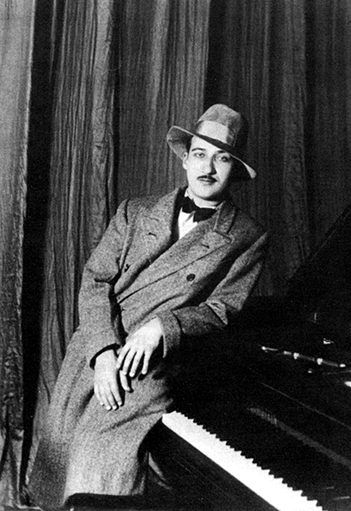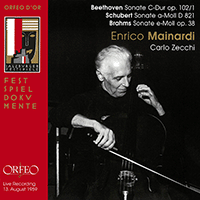Carlo Zecchi
Carlo Zecchi received his first piano lessons from his mother who was herself a pianist. He then had lessons from Francesco Bajardi, a professor at the Accademia di Santa Cecilia in Rome. Zecchi also studied composition with Alessandro Bustini, Licinio Refice and Giacomo Setaccioli.
W.S. Cramp, an American from Philadelphia who lived in Rome, assisted Zecchi financially, enabling him to travel to Berlin where he studied with Ferruccio Busoni for a short period. After the death of Busoni, Zecchi decided to go to Paris, but his debut in that city was given at the same time as that of Vladimir Horowitz by whom he was overshadowed. It was an introduction to Artur Schnabel that led to Zecchi’s return to Berlin to study with the most important teacher of his career. With Schnabel Zecchi studied Schubert, many of the Beethoven piano sonatas, and many of the major works of Schumann including Kreisleriana Op. 16, Davidsbündlertänze Op. 6, Fantasiestücke Op. 12, Kinderszenen Op. 15 and the Humoreske Op. 20.
During the late 1920s and early 1930s Zecchi had great success in Russia, playing in Kiev, Moscow and Leningrad, and becoming so popular that Stalin demanded to meet him. His greatest success as a pianist came in the years between the two World Wars. He then played in South America and toured North America under the management of Columbia Artists, promoting the pianos of Bechstein. He first played in New York at Mrs Lawrence Townsend’s forty-eighth musical morning in January 1931, giving his public debut in New York the following month. In Philadelphia Zecchi played Brahms’s Piano Concerto No. 1 in D minor Op. 15 with Leopold Stokowski and the Philadelphia Orchestra; he also worked with George Szell and Erich Kleiber. When playing in Riga Zecchi met pianist Velta Vait, whom he married in 1936 at Lake Como; his best man was Artur Schnabel, who had left Germany due to the rise of Nazi power. World War II interrupted Zecchi’s career; he returned to Rome where he remained for the entire duration of the war. He was friendly with and played for Mussolini, but disliked Hitler whom he also met and played for. It was during the war that Zecchi gave up solo piano recitals, and from 1939 toured with cellist Enrico Mainardi.
He studied conducting with Hans Münch and Antonio Guarnieri, giving his first performance as conductor in Basle in 1942. Zecchi pursued this other career over the ensuing years, from 1947 appearing as a guest conductor with the Concertgebouw Orchestra, Vienna Philharmonic Orchestra and Leningrad Philharmonic Orchestra. In 1947 he conducted the London Philharmonic Orchestra at London’s Royal Albert Hall when pianist Moura Lympany gave a performance of Beethoven’s Piano Concerto No. 4 in G major Op. 58, and in the same year he conducted the same orchestra in the same work for Decca, when it was recorded with Clara Haskil as soloist. For the rest of his career Zecchi chose to conduct rather than play, and performed throughout the world in places such as New York, Buenos Aires, Tokyo and Sydney. He also taught at the Accademia di Santa Cecilia in Rome and gave summer master-classes in Salzburg from 1948. As late as 1981 Zecchi was travelling to Japan for the seventh time to give master-classes there.
Zecchi’s keyboard style was refined, poised and very graceful, somewhat akin to that of Arturo Benedetti Michelangeli, yet with more warmth. He had a great clarity of articulation which suited both Scarlatti sonatas and Liszt études. He made his first recordings for Odéon in Paris around 1927. While in Moscow in 1928 he recorded for the Russian label Music Trust, the precursor of Melodya, and from these sessions come excellent accounts of Liszt’s La Leggierezza and some Chopin études.
In 1935 Zecchi was again recording in Paris, this time for Ultraphone. From these sessions come excellent accounts of Chopin’s Grande Polonaise in E flat major Op. 22 and Étude in F major Op. 10 No. 8, plus Ravel’s Alborada del gracioso. Zecchi recorded two Liszt études that he would record again for Cetra a few years later, and there are also four scintillating Scarlatti sonatas, three of which he again recorded for Cetra. The sound quality of the Ultraphone recordings is superior to those made for Cetra a few years later, but both pianos are out of tune.
Between 1937 and 1942 Zecchi recorded for Cetra in Turin. He played Schumann’s Kinderszenen Op. 15, and works by Chopin, Schubert, Liszt, Debussy and Ticciati. He also recorded arrangements by Respighi and Reger as well as a Bach prelude and fugue and the Brandenburg Concerto No. 5 in D major BWV 1050. From his first trill in the Chopin Berceuse Op. 57 Zecchi’s suave style is announced, but his rubato in three of the mazurkas is too pronounced. He has a formidable technique enabling him to play three of Liszt’s études with ease, whilst his Poissons d’Or by Debussy is painted in bright shimmering colours. All of these recordings were made on an Italian piano made in Turin.
In February 1956 a full-page advertisement in an American record guide announced the ‘triumphant return to piano records!’ of Zecchi. ‘Titan of the piano since his student days with Busoni, he quit the keyboard for the podium, exclusively. Until Westminster prevailed upon him to return! Here, for the everlasting joy of his worshippers, the awe of newer listeners who have not yet heard him, is the triumphant first fruit: a “Zecchi Piano Recital” of Bach, Chopin, Mozart, Scarlatti, Schumann.’ This LP, made for the American label Westminster, is perhaps not as good as the record company thought, but represents the last time Zecchi visited a recording studio. Works that Zecchi had not recorded before include Mozart’s Piano Sonata in D major K. 311 and Bach’s Three-part Invention in G minor. The Chopin Mazurka in B minor Op. 33 No. 4 is played with exactly the same rubato as in the earlier recording for Cetra.
Private recordings from late in Zecchi’s life exist and have been included in his complete recordings issued on eight compact discs by Fonoteca in Italy.
© Naxos Rights International Ltd. — Jonathan Summers (A–Z of Pianists, Naxos 8.558107–10).



















